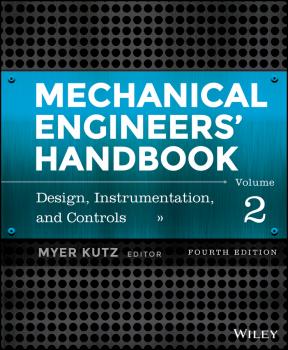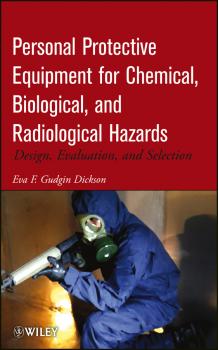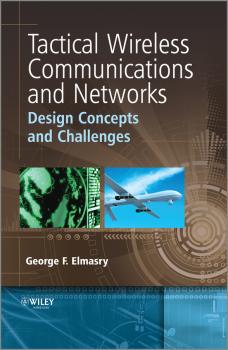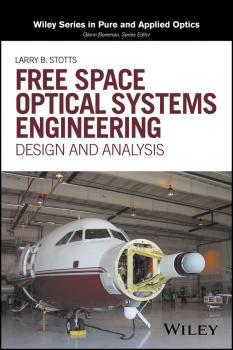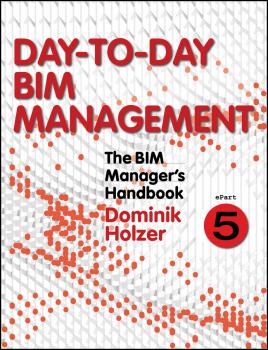ТОП просматриваемых книг сайта:
ЛИТМИР - LITMIR.BIZ - Электронная библиотека
Скачивание или чтение онлайн электронных книг.Аннотация
Full coverage of electronics, MEMS, and instrumentation and control in mechanical engineering This second volume of Mechanical Engineers' Handbook covers electronics, MEMS, and instrumentation and control, giving you accessible and in-depth access to the topics you'll encounter in the discipline: computer-aided design, product design for manufacturing and assembly, design optimization, total quality management in mechanical system design, reliability in the mechanical design process for sustainability, life-cycle design, design for remanufacturing processes, signal processing, data acquisition and display systems, and much more. The book provides a quick guide to specialized areas you may encounter in your work, giving you access to the basics of each and pointing you toward trusted resources for further reading, if needed. The accessible information inside offers discussions, examples, and analyses of the topics covered, rather than the straight data, formulas, and calculations you'll find in other handbooks. Presents the most comprehensive coverage of the entire discipline of Mechanical Engineering anywhere in four interrelated books Offers the option of being purchased as a four-book set or as single books Comes in a subscription format through the Wiley Online Library and in electronic and custom formats Engineers at all levels will find Mechanical Engineers' Handbook, Volume 2 an excellent resource they can turn to for the basics of electronics, MEMS, and instrumentation and control.
Personal Protective Equipment for Chemical, Biological, and Radiological Hazards. Design, Evaluation, and Selection - Eva F. Gudgin Dickson
Аннотация
Personal protective equipment (PPE) is critical for those dealing with toxic, infectious, and radioactive materials. An easily accessible guide for professionals and researchers in all PPE fields, this book takes a fresh look at how PPE is designed, selected, and used in today's emergency response environment where users may need to be protected against deliberately used chemical, biological, or radiological agents in terrorism or warfare scenarios as well as more traditional hazards. Covering the physics, chemistry, and physiology of these hazards, the book explains how PPE protects from various forms of hazards as well as how to use this information to select PPE against these highly hazardous substances for first responder or military users. The design of PPE and components plus relevant performance and evaluation standards are also discussed.
Аннотация
Distillation has historically been the main method for separating mixtures in the chemical process industry. However, despite the flexibility and widespread use of distillation processes, they still remain extremely energy inefficient. Increased optimization and novel distillation concepts can deliver substantial benefits, not just in terms of significantly lower energy use, but also in reducing capital investment and improving eco-efficiency. While likely to remain the separation technology of choice for the next few decades, there is no doubt that distillation technologies need to make radical changes in order to meet the demands of the energy-conscious society. Advanced Distillation Technologies: Design, Control and Applications gives a deep and broad insight into integrated separations using non-conventional arrangements, including both current and upcoming process intensification technologies. It includes: Key concepts in distillation technology Principles of design, control, sizing and economics of distillation Dividing-wall column (DWC) – design, configurations, optimal operation and energy efficient and advanced control DWC applications in ternary separations, azeotropic, extractive and reactive distillation Heat integrated distillation column (HIDiC) – design, equipment and configurations Heat-pump assisted applications (MVR, TVR, AHP, CHRP, TAHP and others) Cyclic distillation technology – concepts, modeling approach, design and control issues Reactive distillation – fundamentals, equipment, applications, feasibility scheme Results of rigorous simulations in Mathworks Matlab & Simulink, Aspen Plus, Dynamics and Custom Modeler Containing abundant examples and industrial case studies, this is a unique resource that tackles the most advanced distillation technologies – all the way from the conceptual design to practical implementation. The author of Advanced Distillation Technologies, Dr. Ir. Anton A. Kiss, has been awarded the Hoogewerff Jongerenprijs 2013. Find out more (website in Dutch)…
Аннотация
Providing a complete description of modern tactical military communications and networks technology, this book systematically compares tactical military communications techniques with their commercial equivalents, pointing out similarities and differences. In particular it examines each layer of the protocol stack and shows how specific tactical and security requirements result in changes from the commercial approach. The author systematically leads readers through this complex topic, firstly providing background on the architectural approach upon which the analysis will be based, and then going into detail on tactical wireless communications and networking technologies and techniques. Structured progressively: for readers needing an overall view; for those looking at the communications aspects (lower layers of the protocol stack); and for users interested in the networking aspects (higher layers of the protocol stack) Presents approaches to alleviate the challenges faced by the engineers in the field today Furnished throughout with illustrations and case studies to clarify the notional and architectural approaches Includes a list of problems for each chapter to emphasize the important aspects of the topics covered Covers the current state of tactical networking as well as the future long term evolution of tactical wireless communications and networking in the next 50 years Written at an advanced level with scope as a reference tool for engineers and scientists as well as a graduate text for advanced courses
Аннотация
Structural engineering is central to the design of a building. How the building behaves when subjected to various forces – the weight of the materials used to build it, the weight of the occupants or the traffic it carries, the force of the wind etc – is fundamental to its stability. The alliance between architecture and structural engineering is therefore critical to the successful design and completion of the buildings and infrastructure that surrounds us. Yet structure is often cloaked in mathematics which many architects and surveyors find difficult to understand. How Structures Work has been written to explain the behaviour of structures in a clear way without resorting to complex mathematics. This new edition includes a new chapter on construction materials, and significant revisions to, and reordering of the existing chapters. It is aimed at all who require a good qualitative understanding of structures and their behaviour, and as such will be of benefit to students of architecture, architectural history, building surveying and civil engineering. The straightforward, non-mathematical approach ensures it will also be suitable for a wider audience including building administrators, archaeologists and the interested layman.
Аннотация
Gets you quickly up to speed with the theoretical and practical aspects of free space optical systems engineering design and analysis One of today's fastest growing system design and analysis disciplines is free space optical systems engineering for communications and remote sensing applications. It is concerned with creating a light signal with certain characteristics, how this signal is affected and changed by the medium it traverses, how these effects can be mitigated both pre- and post-detection, and if after detection, it can be differentiated from noise under a certain standard, e.g., receiver operating characteristic. Free space optical systems engineering is a complex process to design against and analyze. While there are several good introductory texts devoted to key aspects of optics—such as lens design, lasers, detectors, fiber and free space, optical communications, and remote sensing—until now, there were none offering comprehensive coverage of the basics needed for optical systems engineering. If you're an upper-division undergraduate, or first-year graduate student, looking to acquire a practical understanding of electro-optical engineering basics, this book is intended for you. Topics and tools are covered that will prepare you for graduate research and engineering in either an academic or commercial environment. If you are an engineer or scientist considering making the move into the opportunity rich field of optics, this all-in-one guide brings you up to speed with everything you need to know to hit the ground running, leveraging your experience and expertise acquired previously in alternate fields. Following an overview of the mathematical fundamentals, this book provides a concise, yet thorough coverage of, among other crucial topics: Maxwell Equations, Geometrical Optics, Fourier Optics, Partial Coherence theory Linear algebra, Basic probability theory, Statistics, Detection and Estimation theory, Replacement Model detection theory, LADAR/LIDAR detection theory, optical communications theory Critical aspects of atmospheric propagation in real environments, including commonly used models for characterizing beam, and spherical and plane wave propagation through free space, turbulent and particulate channels Lasers, blackbodies/graybodies sources and photodetectors (e.g., PIN, ADP, PMT) and their inherent internal noise sources The book provides clear, detailed discussions of the basics for free space optical systems design and analysis, along with a wealth of worked examples and practice problems—found throughout the book and on a companion website. Their intent is to help you test and hone your skill set and assess your comprehension of this important area. Free Space Optical Systems Engineering is an indispensable introduction for students and professionals alike.
Аннотация
Population ecology has matured to a sophisticated science with astonishing potential for contributing solutions to wildlife conservation and management challenges. And yet, much of the applied power of wildlife population ecology remains untapped because its broad sweep across disparate subfields has been isolated in specialized texts. In this book, L. Scott Mills covers the full spectrum of applied wildlife population ecology, including genomic tools for non-invasive genetic sampling, predation, population projections, climate change and invasive species, harvest modeling, viability analysis, focal species concepts, and analyses of connectivity in fragmented landscapes. With a readable style, analytical rigor, and hundreds of examples drawn from around the world, Conservation of Wildlife Populations (2nd ed) provides the conceptual basis for applying population ecology to wildlife conservation decision-making. Although targeting primarily undergraduates and beginning graduate students with some basic training in basic ecology and statistics (in majors that could include wildlife biology, conservation biology, ecology, environmental studies, and biology), the book will also be useful for practitioners in the field who want to find – in one place and with plenty of applied examples – the latest advances in the genetic and demographic aspects of population ecology. Additional resources for this book can be found at: www.wiley.com/go/mills/wildlifepopulations.
Advanced Instrumentation and Computer I/O Design. Defined Accuracy Decision, Control, and Process Applications - Patrick Garrett H.
Аннотация
Written by an expert in the field of instrumentation and measurement device design, this book employs comprehensive electronic device and circuit specifications to design custom defined-accuracy instrumentation and computer interfacing systems with definitive accountability to assist critical applications. Advanced Instrumentation and Computer I/O Design, Second Edition begins by developing an understanding of sensor-amplifier-filter signal conditioning design methods, enabled by device and system mathematical models, to achieve conditioned signal accuracies of interest and follow-on computer data conversion and reconstruction functions. Providing complete automated system design analyses that employ the Analysis Suite computer-assisted engineering spreadsheet, the book then expands these performance accountability methods—coordinated with versatile and evolving hierarchical subprocesses and control architectures—to overcome difficult contemporary process automation challenges combining both quantitative and qualitative methods. It then concludes with a taxonomy of computer interfaces and standards including telemetry, virtual, and analytical instrumentation. Advanced Instrumentation and Computer I/O Design, Second Edition offers: Updated chapters incorporating the latest electronic devices and system applications Improved accuracy of the design models between their theoretical derivations and actual measured results End-of-chapter problems based on actual industry, laboratory, and aerospace system designs Multiple real-world case studies performed for technology enterprises Instrumentation Analysis Suite for computer I/O system design A separate solutions manual Written for international engineering practitioners who design and implement industrial process control systems, laboratory instrumentation, medical electronics, telecommunications, and embedded computer systems, this book will also prove useful for upper-undergraduate and graduate-level electrical engineering students.
Case Studies in Mechanical Engineering. Decision Making, Thermodynamics, Fluid Mechanics and Heat Transfer - Stuart Sabol
Аннотация
Using a case study approach, this reference tests the reader’s ability to apply engineering fundamentals to real-world examples and receive constructive feedback Case Studies in Mechanical Engineering provides real life examples of the application of engineering fundamentals. They relate to real equipment, real people and real decisions. They influence careers, projects, companies, and governments. The cases serve as supplements to fundamental courses in thermodynamics, fluid mechanics, heat transfer, instrumentation, economics, and statistics. The author explains equipment and concepts to solve the problems and suggests relevant assignments to augment the cases. Graduate engineers seeking to refresh their career, or acquire continuing education will find the studies challenging and rewarding. Each case is designed to be accomplished in one week, earning up to 15 hours of continuing education credit. Each case study provides methods to present an argument, work with clients, recommend action and develop new business. Key features: Highlights the economic consequences of engineering designs and decisions. Encourages problem solving skills. Application of fundamentals to life experiences. Ability to practice with real life examples. Case Studies in Mechanical Engineering is a valuable reference for mechanical engineering practitioners working in thermodynamics, fluid mechanics, heat transfer and related areas.
Аннотация
ePart 5: Day-to-Day BIM Management: How do you go about mastering hands-on support BIM for your team? ePart 5 introduces the operational tasks a BIM Manager is expected to accomplish. Depending on an organisation’s size BIM Managers either supervise the rollout of BIM on various projects, or they actively get involved in mentoring those authoring or coordinating information in BIM. By providing a strong project focus, this ePart, firstly, addresses requirements for in-house BIM project support; secondly, it explains how to support the integration and coordination of BIM data across a multi-disciplinary project team. Leading BIM experts from the US, UK and Australia divulge their recipes for successful operational management. Obook ISBN: 9781118987902; ePub ISBN:9781118987919; ePDF ISBN: 9781118987926; published November 2015

